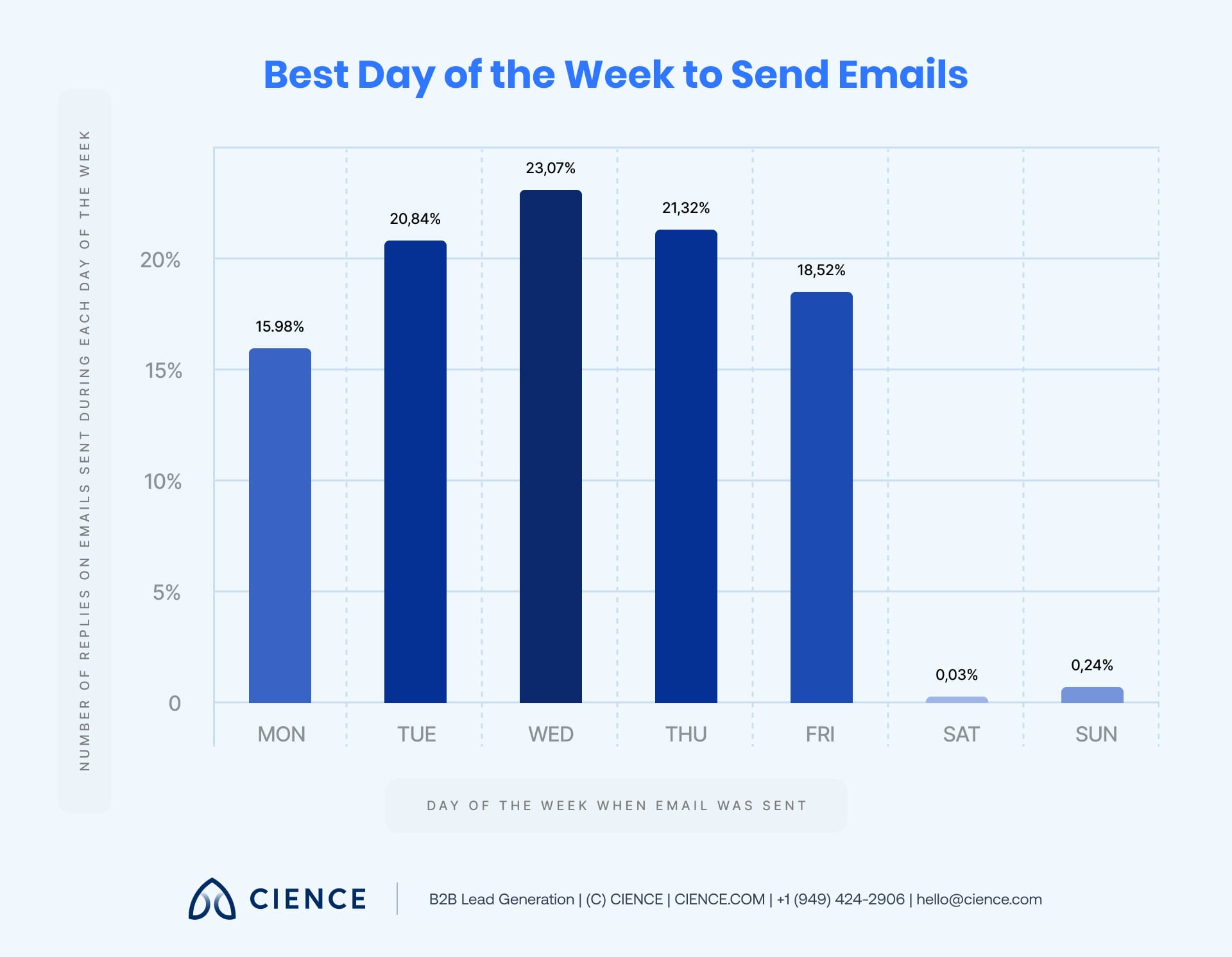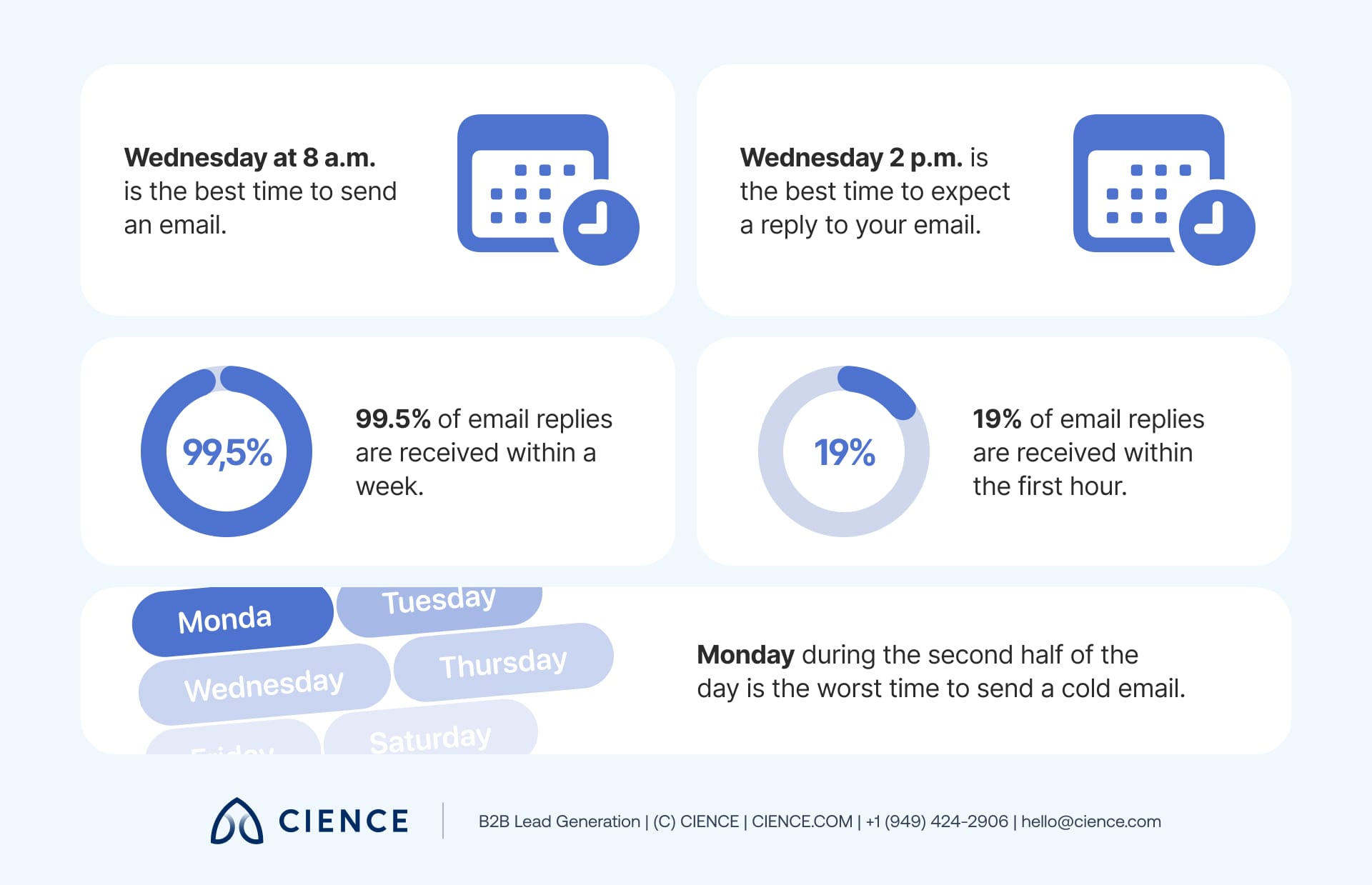What is the Best Time to Send a Cold Email to Get a Response
The average B2B sales cycle gets closed in 102 days. It takes 6.8 seconds to connect a salesperson with the prospect over the phone and milliseconds to get the message delivered online. The average speed of a data packet is 124,300 miles per second, which means that your email travels five times around the Earth before you even take away the finger from the “send” button.
The sales process is all about correctly using those milliseconds, seconds, and days to reach prospects. However, even now, when having such powerful tools available for every salesperson, one thing still remains unclear: When is the best time to send your emails to the prospect? When searching for the answer to this fundamental question, Google offers over four billion search results. Very confusing, right?

CIENCE SDRs have sent thousands of emails daily for over six years now. During these years, we’ve developed a deep understanding of how cold emails work and how to use this channel sufficiently. Now, we’ve decided to put this knowledge into numbers and share it with you in our brand-new study about the best time to send a cold email.
Most studies dedicated to this topic define the best time to send an email based on the open rate. However, an opened email does not appoint the success of the email campaign—conversions do. The prospect may not even skim through the email before closing it nor actually reading its content. To get more precise information on the best time to send emails that convert into closed sales, CIENCE chose a different approach based on the reply rate instead of the open rate.
Research Sample & Findings
The data on the emails sent were collected during the period from Jan. 1, 2021, until May 25, 2021. CIENCE Data Labs has analyzed six million rows of information for calculating durations in time before receiving the reply and 600,000 rows (which indicated the time zone of the recipient) for the best time to send emails and get a reply in hours and days.
1. What is the best time of the day to send an email?

According to our data, 20% of all replied emails were sent at 8 a.m, which makes it the best time of the day to send a cold email. Other good time slots were 5 a.m. (13%) and 9 a.m. (12%). Such an early-time reply preference for email outreach suggests that sending emails early in the morning ensures that they will be at the top of the inbox at the beginning of the workday. Any other time slot between 4 a.m. and 12 a.m. shows moderately good results in the level of replied emails too.
The trendline starts to decrease steadily starting from 1 p.m. and keeps going down until the very early morning (3 a.m.). When planning your sales agenda for the day, email outreach should be the top priority in the morning. Sending even the most brilliant email after lunch risks being ignored by the prospect. If for some reason morning outreach isn’t an option, consider using automation tools to set the precise time for sending cold emails.
2. What is the best time of day to expect an email reply?

It’s quite curious that when it comes to prospects’ replies to your emails, there is no obvious trendline from previous data. Recipients are inconsistent about when exactly to send their answers back. Some of them prefer doing it the moment they read the email (from 5 a.m. till 8 a.m.), while others opt to wait until the start of the workday (9 a.m). There is also a huge spike in the email replies sent after lunchtime (2 p.m.). After this spike, there is only a small cumulative percentage of emails that are replied to at the end of the workday. The data suggests that prospects choose to deal with most emails during the first half of the day.
3. What is the best time of the week to send an email?

Based on the bar chart above, the best day of the week to send an email is Wednesday (23%) while the worst option (except for the weekends) is Monday (16%). Most likely, Mondays are already overwhelmed by the inside-the-office updates, and by Wednesday, your prospects free up some time to check out those not-so-urgent emails.
Overall, the trendline for this data is a bell-shaped curve that steadily increases at the beginning of the workweek, reaches its peak during midweek, decreases closer to the end, and breaks up sharply when the weekend comes.
4. What is the best time of the week to expect an email reply?

Based on our research, prospects prefer to reply to the emails midweek, specifically on Wednesday (23%), which indicates more time to reply and catch up during the midweek. Not surprisingly, the least amount of replies occur on Fridays (17%) when people are setting off for their weekends.
5. How many hours does it take to receive a reply?

When it comes to the duration before the reply, 19% of all email replies are received within the first hour after the email was sent; 77% of them are answered within the first twelve hours.

The more time passes after the email was sent, the fewer chances to receive a reply there are. The percentage of email replies during the second hour after they were sent is 15%; during the fourth hour—9%. Only 2.6% of email responses are received during the eighth hour after they were sent. If your email doesn’t get noticed during the first twelve hours, the chances of the prospect getting back to you any hour after that are extremely low—not more than 1.1%.
The data reveals that if you want your email to be replied to, make sure to trigger your recipient to get back to you immediately by including a clear and precise call-to-action message.
6. How many days does it take to receive a reply?

Our research shows that 87% of all emails are replied to within the first day, followed by only 5.5% of replies on the second day. 99.5% of all replies are received within seven days after the email was sent.
The graph above should be a huge tip-off on how to build a follow-up timeline strategy for your team. As you can see, there is no reason to wait for more than three days before sending the first follow-up message. Link this information with your best practices and increase the reply rate significantly.
Key Takeaways from the Study
Timing is the key to high conversions, ROI, and increased revenues. Using it correctly for the cold email outreach can improve your sales team’s performance significantly. Our study has proven that certain time slots and days of the week work better than others if you aim to get a reply from the recipient. Try combining them in different ways and figure out which one works the best for your business.
To sum up, here is a quick overview of the key findings:

Need help with figuring the best time to send cold emails for your business?Contact us!
